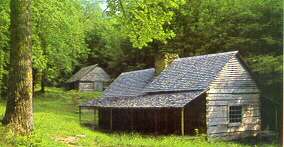The Iron Industry in West Kentucky
Aug 11, 1979
Before William Kelley perfected his process for manufacturing Iron, using
oxygen to heat the fire to very high temperatures and producing a better grade of finished product, the Iron furnaces in this area were operated on
what was referred to as the cold-blast process. This process necessitated large amounts of charcoal for use as fuel in the furnaces.
Keeping an Iron furnace going required as many as 150 men for the larger furnaces. Slave labor was used to some extent, as was Imported Chinese labor. A good part of the labor force was used strictly in the production of the charcoal which fired the furnaces. For this reason, one of the prime considerations in locating the furnace was the availability of vast amounts of timber. It was also necessary to find a source of limestone with which to construct the furnace Itself, and a dependable source of running water for use in the smelting process. The furnaces were located near the Tennessee and Cumberland Rivers for easy access to a shipping point.
Most of the Iron masters had come to this part of the country from Pennsylvania where they had learned the trade. Although the Iron ore found around here was not considered top grade, It was plentiful enough to be considered one of the main sources prior to the Civil War.
The cold-blast process of making iron was dependent upon intense heat, supplied by charcoal, to melt the Iron ore and separate It from the other minerals present
The method of producing charcoal for fuel was a lengthy and tedious job. Hardwoods were cut into four foot lengths and stacked into cords. A pit was built for burning the wood; this pit would be about 30 feet in diameter. The cords of wood were put into the coal pit, each of which was capable of containing 60 cords. In the center of the hearth, a three-cornered pen was built and wood was set on end around the pen in a circle, building up to a height of twelve feet.
This wood filled pit was then covered with eight inches of leaves, to protect the wood from dirt. On top of the leaves was shoveled clay, to a thickness of six inches on the sides and about 18 Inches on top. This was done to keep the heat Inside the pit.
To light the pit, a worker climbed a ladder to the top, opened the top of the pIt and shoveled kindling into the pen, which served as a chimney. Then a fire was built on the shovel and placed down inside the pen and re-covered with dirt, leaving two holes through which the smoke and gases could escape.
After about a day, smoke would begin to emerge from the "chimney," and some four days later, more holes were made and the pit was left to burn for a week or two, until the coal was ready to draw. The fire had to be watched around the clock. Since the charcoal pits were usually located in a valley, there could be as many as 50 burning simultaneously.
When the coal was ready to draw, the workers would make a hole at the base of the pit and take out the coal with a long handled shovel. Water was kept nearby to douse any remaining flames.
This ever-present danger resulted in many charcoal wagons being Irreparably damaged; for this reason, buckets of water were kept at close intervals along the routes to the iron furnace
When the charcoal had cooled, it was placed in large, shallow baskets and then into the wagons to be taken to the furnace. It took about 2000 bushels of charcoal to feed an Iron furnace for a 24-hour period.
The vast amounts of wood necessary for the cold-blast process resulted in a search for a more economical method of keeping the furnaces heated to the proper temperature. In the next column, we will see how William Kelley solved this problem.

